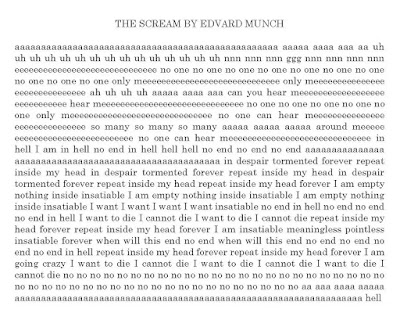https://poetryofgonzalinhodacosta.blogspot.com/2022/09/the-scream-by-edvard-munch.html
The poem uses full justification in order to maintain a block shape. The block shape simplifies the perceptual features of the poem and achieves a special impact. Text crowding is also essential to the poem. The poem should be exactly 23 lines long.
To achieve the aforementioned attributes, the width of the poem should be adjusted and the last line should add as many “a’s” to the “a” string as may be required to ensure that the last word, “hell,” ends at the edge of the right margin.
This procedure is illustrated in the second and third versions of the poem, which are formatted in Times New Roman 12 points and Georgia 12 points, respectively.
In the second version of the poem, the width has been adjusted from 6 inches to 5.75 inches and seven “a’s” have been added to the “a” string in the last line. The last line has 73 “a’s.” The original version of the poem, which is formatted in Century Schoolbook 12 points, has 66 “a’s” in the last line.
The third version of the poem adjusts the width from 6 inches to 6.25 inches and adds four “a’s” to the “a” string in the last line. The last line has 70 “a’s.”
%20by%20Edvard%20Munch.jpg)



Images of works of art are posted on this website according to principles of fair use—specifically, they are posted for the purposes of information, education, and especially, contemplation.
ReplyDeleteThe purpose of this blog is, among others, to advance knowledge and to create culture, for public benefit.
The poem discussed in this post is about “The Scream” by Edvard Munch. Four versions of this artwork are known to exist—two from 1893, and one each from 1895 and 1910.
Gonzalinho
“The Scream by Edvard Munch” is a visual poem in which the format conveys meaning because the rectangular shape communicates the constraining character of the punishment of the damned in Hell. In Hell the condemned are imprisoned forever and turned in upon themselves, unable to relate in love to God or to others outside their place of everlasting confinement.
ReplyDeleteSaint Teresa of Avila’s mystical experience of Hell indicates its defining bounded character.
“A long time after the Lord had granted me many of the favours which I have described, together with other very great ones, I was at prayer one day when suddenly, without knowing how, I found myself, as I thought, plunged right into hell. I realized that it was the Lord's will that I should see the place which the devils had prepared for me there and which I had merited for my sins. This happened in the briefest space of time, but, even if I were to live for many years, I believe it would be impossible for me to forget it. The entrance, I thought, resembled a very long, narrow passage, like a furnace, very low, dark and closely confined; the ground seemed to be full of water which looked like filthy, evil-smelling mud, and in it were many wicked-looking reptiles. At the end there was a hollow place scooped out of a wall, like a cupboard, and it was here that I found myself in close confinement. But the sight of all this was pleasant by comparison with what I felt there. What I have said is in no way an exaggeration.” (Saint Teresa of Avila, Autobiography, Chapter 32, 1)
Gonzalinho
The fate of the damned is unspeakable.
ReplyDeleteIf you knew what Hell is, you would willingly suffer the worst torments on earth to save yourself from eternal death.
“What is hell? I maintain that it is the suffering of being unable to love.”—Fyodor Dostoevsky, The Brothers Karamazov, Chapter 41
Dostoevsky describes the essential punishment of Hell, the pain of loss.
Gonzalinho
This poem was originally published in Torrid Literature Journal, Volume XXVII (June 2022), page 49.
ReplyDeleteGonzalinho
INFLUENCES ON “THE SCREAM BY EDVARD MUNCH” BY GONZALINHO DA COSTA
ReplyDeleteGraphic poetry - Earliest examples date to Greek antiquity. In graphic poetry, the poem is also a picture.
“Figure poems–a visual poem that manifests in the form of an object–have been popular since Greek antiquity. In the 6th c. BCE, Simonides of Keos famously claimed that poetry was a speaking picture, while painting was a mute poem (Plut. Mor. 347A). Figure poetry remained a poetic genre into Roman antiquity and the middle ages, when they were often called carmina figurata. Perhaps the best known figure poem today is “The Altar” by the 17th century Welsh poet George Herbert, but before Herbert’s altar, there were altar poems by Dosiados (c. 150 BCE) and Besantinus (c. 117 CE).”
https://sarahemilybond.com/2016/02/04/using-graphic-language-a-short-history-of-figure-poems/
—Sarah E. Bond, “Using Graphic Language: A Short History of Figure Poems,” History from Below
Virginia Woolf - One of the principal Modernist pioneers of stream-of-consciousness narrative technique in literature
“Stream of consciousness is a narrative device that is the written equivalent to a character’s thought process—or a stylized way of thinking out loud. It is often written in first person and is less ordered and occasionally more jumbled than an internal monologue, which is most often written in third person and follows a slightly more structured flow of thoughts to depict a characters’ opinions of his environment.”
https://mastersreview.com/craft-lessons-and-prompts-stream-of-consciousness-and-virginia-woolf/
—“Craft Lessons and Prompts – Stream of Consciousness and Virginia Woolf,” The Masters Review Blog
Jose Garcia Villa - Introduced comma poetry as a Modernist technique
“José does use the comma as a virtuoso, sometimes to great effect, but the eye sometimes fatigues from all those commas. In the best examples, the commas significantly increase the wonder of the poem; in the worst, this new use of commas seems rather too clever and precious.”
https://scholarworks.gvsu.edu/cgi/viewcontent.cgi?article=1131&context=spring_cummings
—Thomas Dorsett, “The Poetry of José Garcia Villa,” Spring: The Journal of the E. E. Cummings Society (2007), Volume 16, Article 17, page 174
Gonzalinho